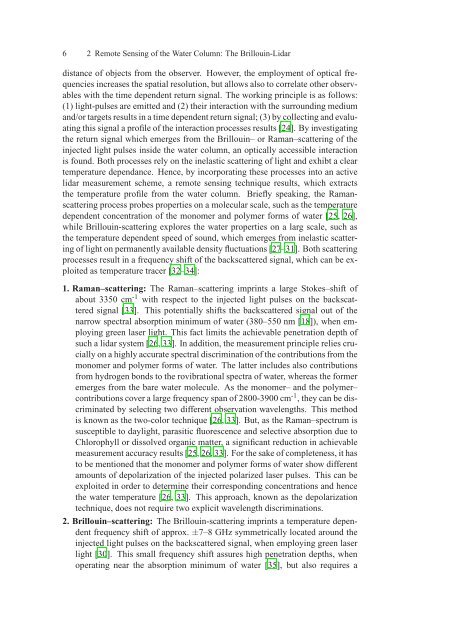Assessment of a Rubidium ESFADOF Edge-Filter as ... - tuprints
Assessment of a Rubidium ESFADOF Edge-Filter as ... - tuprints
Assessment of a Rubidium ESFADOF Edge-Filter as ... - tuprints
You also want an ePaper? Increase the reach of your titles
YUMPU automatically turns print PDFs into web optimized ePapers that Google loves.
6 2 Remote Sensing <strong>of</strong> the Water Column: The Brillouin-Lidar<br />
distance <strong>of</strong> objects from the observer. However, the employment <strong>of</strong> optical frequencies<br />
incre<strong>as</strong>es the spatial resolution, but allows also to correlate other observables<br />
with the time dependent return signal. The working principle is <strong>as</strong> follows:<br />
(1) light-pulses are emitted and (2) their interaction with the surrounding medium<br />
and/or targets results in a time dependent return signal; (3) by collecting and evaluating<br />
this signal a pr<strong>of</strong>ile <strong>of</strong> the interaction processes results [24]. By investigating<br />
the return signal which emerges from the Brillouin– or Raman–scattering <strong>of</strong> the<br />
injected light pulses inside the water column, an optically accessible interaction<br />
is found. Both processes rely on the inel<strong>as</strong>tic scattering <strong>of</strong> light and exhibt a clear<br />
temperature dependance. Hence, by incorporating these processes into an active<br />
lidar me<strong>as</strong>urement scheme, a remote sensing technique results, which extracts<br />
the temperature pr<strong>of</strong>ile from the water column. Briefly speaking, the Ramanscattering<br />
process probes properties on a molecular scale, such <strong>as</strong> the temperature<br />
dependent concentration <strong>of</strong> the monomer and polymer forms <strong>of</strong> water [25, 26],<br />
while Brillouin-scattering explores the water properties on a larg scale, such <strong>as</strong><br />
the temperature dependent speed <strong>of</strong> sound, which emerges from inel<strong>as</strong>tic scattering<br />
<strong>of</strong> light on permanently available density fluctuations [27–31]. Both scattering<br />
processes result in a frequency shift <strong>of</strong> the backscattered signal, which can be exploited<br />
<strong>as</strong> temperature tracer [32–34]:<br />
1. Raman–scattering: The Raman–scattering imprints a large Stokes–shift <strong>of</strong><br />
about 3350 cm -1 with respect to the injected light pulses on the backscattered<br />
signal [33]. This potentially shifts the backscattered signal out <strong>of</strong> the<br />
narrow spectral absorption minimum <strong>of</strong> water (380–550 nm [18]), when employing<br />
green l<strong>as</strong>er light. This fact limits the achievable penetration depth <strong>of</strong><br />
such a lidar system [26, 33]. In addition, the me<strong>as</strong>urement principle relies crucially<br />
on a highly accurate spectral discrimination <strong>of</strong> the contributions from the<br />
monomer and polymer forms <strong>of</strong> water. The latter includes also contributions<br />
from hydrogen bonds to the rovibrational spectra <strong>of</strong> water, where<strong>as</strong> the former<br />
emerges from the bare water molecule. As the monomer– and the polymer–<br />
contributions cover a large frequency span <strong>of</strong> 2800-3900 cm -1 , they can be discriminated<br />
by selecting two different observation wavelengths. This method<br />
is known <strong>as</strong> the two-color technique [26, 33]. But, <strong>as</strong> the Raman–spectrum is<br />
susceptible to daylight, par<strong>as</strong>itic fluorescence and selective absorption due to<br />
Chlorophyll or dissolved organic matter, a significant reduction in achievable<br />
me<strong>as</strong>urement accuracy results [25, 26, 33]. For the sake <strong>of</strong> completeness, it h<strong>as</strong><br />
to be mentioned that the monomer and polymer forms <strong>of</strong> water show different<br />
amounts <strong>of</strong> depolarization <strong>of</strong> the injected polarized l<strong>as</strong>er pulses. This can be<br />
exploited in order to determine their corresponding concentrations and hence<br />
the water temperature [26, 33]. This approach, known <strong>as</strong> the depolarization<br />
technique, does not require two explicit wavelength discriminations.<br />
2. Brillouin–scattering: The Brillouin-scattering imprints a temperature dependent<br />
frequency shift <strong>of</strong> approx. ±7–8 GHz symmetrically located around the<br />
injected light pulses on the backscattered signal, when employing green l<strong>as</strong>er<br />
light [30]. This small frequency shift <strong>as</strong>sures high penetration depths, when<br />
operating near the absorption minimum <strong>of</strong> water [35], but also requires a
















